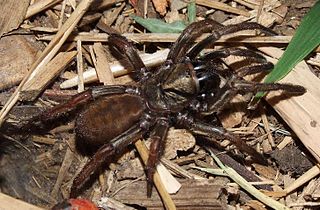
Idiopidae, also known as armored trapdoor spiders, is a family of mygalomorph spiders first described by Eugène Simon in 1889. They have a large body similar to tarantulas.

Idiosoma is a genus of Australian armoured trapdoor spiders that was first described by Anton Ausserer in 1871. Originally placed with the Ctenizidae, it was moved to the armoured trapdoor spiders in 1985. The name is derived from the Greek ἴδιος, meaning "individual, unique", and σῶμα, meaning "body", referring to the distinctive structure of the abdomen.

Arbanitis is a genus of Australian armoured trapdoor spiders that was first described by Ludwig Carl Christian Koch in 1874.
Euoplos is a genus of Australian armoured trapdoor spiders that was first described by William Joseph Rainbow in 1914.

Gaius villosus is a species of spider in the family Idiopidae found in Western Australia in a variety of different habitats.
Eucanippe is a genus of Western Australian armored trapdoor spiders first described by Michael Gordon Rix, Robert J. Raven, Barbara York Main, S. E. Harrison, A. D. Austin, S. J. B. Cooper & Mark Stephen Harvey in 2017.
Bungulla is a genus of Australian armoured trapdoor spiders first described by Michael Gordon Rix, Robert John Raven, Barbara York Main & Mark Stephen Harvey in 2017.
Cryptoforis is a genus of Australian armoured trapdoor spiders. It was first described by J. D. Wilson, Robert Raven and Günter E. W. Schmidt in 2020, and it has only been found in Australia.
Arbanitis andrewsi is a species of armoured trap-door spider in the family Idiopidae, and is endemic to South Australia.
Arbanitis crispus is a species of armoured trap-door spider in the family Idiopidae, and is endemic to Tasmania.
Arbanitis echo is a species of armoured trap-door spider in the family Idiopidae, and is endemic to New South Wales and Queensland.
Arbanitis ornatus is a species of armoured trap-door spider in the family Idiopidae, and is endemic to Queensland.
Arbanitis villosus is a species of armoured trap-door spider in the family Idiopidae, and is endemic to New South Wales.
Arbanitis hirsutus is a species of armoured trap-door spider in the family Idiopidae, and is endemic to New South Wales and Queensland.
Arbanitis maculosus is a species of armoured trap-door spider in the family Idiopidae, and is endemic to New South Wales.
Arbanitis montanus is a species of armoured trap-door spider in the family Idiopidae, and is endemic to New South Wales.
Arbanitis melancholicus is a species of armoured trap-door spider in the family Idiopidae, and is endemic to New South Wales.
Idiosoma castellum is a trapdoor spider in the Arbanitinae subfamily of the Idiopidae family. It was first described as Aganippe castellum by Barbara York Main in 1986. In 2017 Michael Rix and others transferred it to the genus, Idiosoma, to give the name Idiosoma castellum,.
Idiosoma cupulifex is a trapdoor spider in the Arbanitinae subfamily of the Idiopidae family. It was first described as Aganippe cupulifex by Barbara York Main in 1957. In 2017 Michael Rix and others transferred it to the genus, Idiosoma, to give the name Idiosoma cupulifex,.
Bungulla bertmaini is a species of mygalomorph spider in the Idiopidae family. It is endemic to Australia. It was described in 2017 by Australian arachnologists Michael Rix, Barbara York Main, Robert Raven and Mark Harvey.





